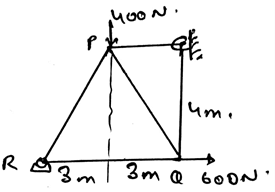Test: Method Of Joints - Civil Engineering (CE) MCQ
15 Questions MCQ Test - Test: Method Of Joints
If the whole truss is in equilibrium then all the joints which are connected to that truss is in equilibrium. This is known as:
Find the force in the member vertical at the right, joined by the hinge.

The free body diagram of which part of the section of the truss is made to make use of method of joints?
For applying the method of joint at joints the forces need to coplanar.
For applying the method of joint at joints the forces need to be concurrent.
We use the method of joint to find the forces acting over the joints. In this we start from the joint having at least one known force and at the most two unknown forces.
We use the method of joint to find the net force acting over the entire structure.
The magnitude of the unknown force can’t be known. But the direction can be founded out.
What is after taking the assumption of the direction of the force, the direction comes opposite?
The resultant of three equal vectors having mutual angles being 120 degree and being originated from a single point is zero.
The magnitude of the resultant of the two vectors is always:














